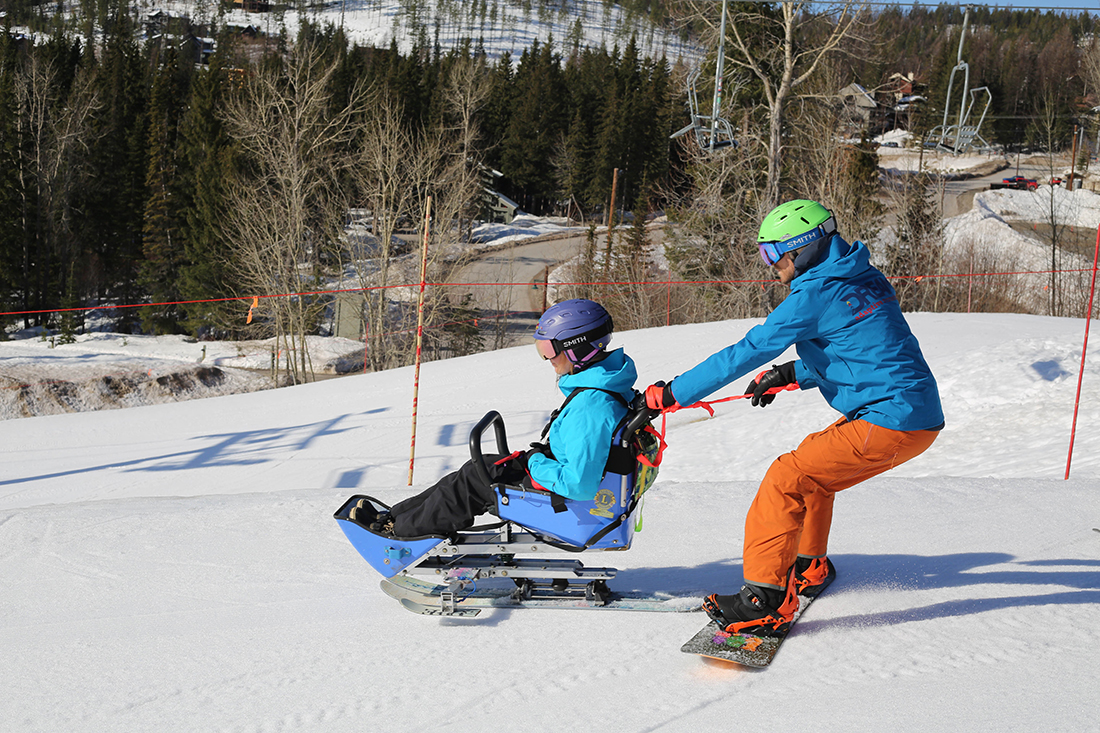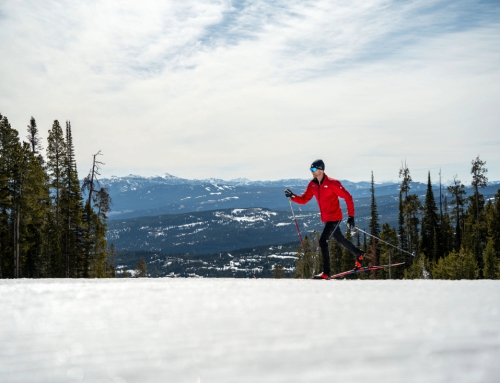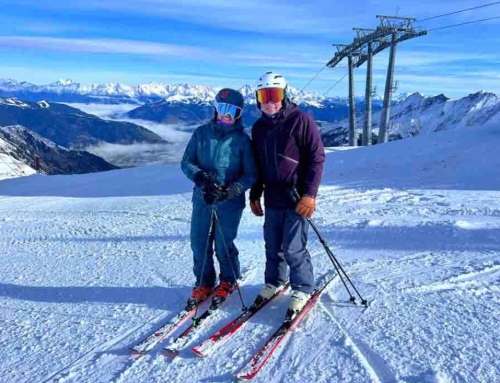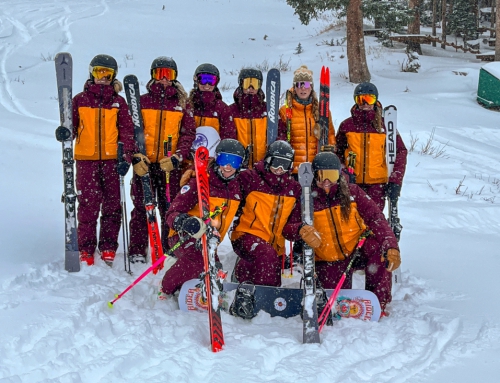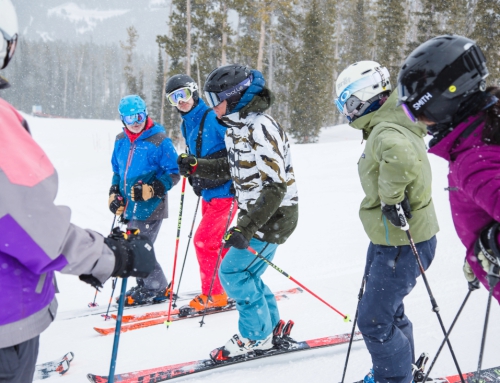32 Degrees: Improve Tethering for a Better Bi-Ski Experience
This article by Trevor Hildebrand originally appeared in the Fall 2022 issue of 32 Degrees, which you can read in its entirety here.
Adaptive instructors aim to promote independence, helping students achieve whatever level of skiing or riding movements they’re physically and cognitively capable of performing. We supplement that approach with assistance, as needed.
In the case of bi-skiing – whether the student uses handheld outriggers, fixed outriggers, or a combination of both – students often benefit from being tethered (rather than being seat-assisted or “driven”) because this allows the student to be more involved in their on-snow experience. There’s much that the tethering instructor can do to influence and support that experience, and it’s all controllable and teachable.
Just like a run for any of us, when the run starts bad, it’s hard to catch up and make the run good. So, let’s look at how to start the run successfully for tethering a bi-ski with fixed outriggers or handheld outriggers, where the student needs a moderate amount of tethering assistance.
Prevent ‘Whiplash’ and Wobbles
Learning to tether a bi-ski often takes days to weeks of guided practice to gain a foundation of skills that directly relate to the student’s learning experience. One key to delivering exceptional adaptive experiences is to be aware of how cause-and-effect relationships of your performance relate to your students’ experience.
One important element of tethering involves the hands-off transition, when the instructor goes from holding the back of the ski to establishing the connection through tethers. This most commonly occurs when the instructor is starting downhill from a stopped position. In my experience, there are two common effects that bi-ski students find unnerving and often mention as their least favorite part of the sport.
The first is when the instructor begins the hands-off transition with slack in the tethers and pushes the bi-ski forward to move to tethers. This can create an immediate and unnatural acceleration followed by an unnatural deceleration; essentially producing a whiplash effect.
The second effect is an oscillation (or wobble) after transitioning to tethers, and there are several potential causes. In one scenario, if a bi-ski with fixed outriggers is not pointed down the fall line when the instructor moves to tethers, the skis beneath the seat want to fall toward the downhill outrigger, throwing the skier off balance. That same “fall toward an outrigger” can be caused by the instructor pushing down on the handle, rotating the bi-ski upon release, applying unequal tension to the tethers, or releasing tension when the tethers should be taut.
Each of these falls onto an outrigger can cause the bi-skier to bounce off that outrigger and onto the other, causing oscillations. Oscillations are dangerous because they’re the precursor to the bi-ski cartwheeling or falling over… so tetherers want to avoid the wobbles whenever possible.
Tactics for Transition to Tethers
Luckily, each of these effects – whiplash and oscillation – has a single fix for skiers and snowboarders transitioning to tethers, with a second option for snowboarders. I call this “Hip-Hip, Flippity-Flip” (shout-out to Elise Cozzens at Red Lodge, Montana, for the name). For the dual-discipline method, snowboarders orient themselves in a T-frame (with the snowboard centered behind and perpendicular to the bi-ski) while skiers place one ski on each side of the bi-ski, as if bracketing it.
Using proper positioning and smooth tethering technique is the bi-ski equivalent of starting the initiation phase of a turn in a neutral, athletic stance. It’s an important method to help the bi-skier move to greater independence on tethers through balance, movement patterns, and stance.
- Hip: The tethering instructor points the bi-ski directly down the fall line and, with tethers wrapped up with less than 18 inches of slack in them, moves one hand back toward their corresponding hip until the tether is tensioned.
- Hip: Assuming the bi-skier is properly fitted within the seat (centered and with necessary padding added to fill gaps), the bi-ski will be stable in the fall line, allowing the instructor to move their other hand back toward the corresponding hip until the second tether is also taut.
- Flippity-Flip: The tetherer then applies a little braking power to their sliding device to slow down slightly in relation to the bi-ski, while smoothly unwrapping the tethers on both hands 2-4 times until their sliding device(s) is clear of the bi-ski tails. To maintain tension on the tethers, the instructor flips their hands in a circular pattern to control the release of the tethers, hence the flippity-flip.
At this point, the instructor is free to perform whatever maneuver is necessary to move down the hill safely with the student.
Snowboarders have a second option:
- The instructor starts by driving (seat-assisting) on the high-side of the bi-ski – for the pictured example, traversing across the hill to the right, with the right-side fixed outrigger pressured into the hill. The tethers are wrapped up with less than 18 inches of slack in them.
- Hip: The tetherer then moves their left hand off the handlebar and pulls the tether taut toward their left hip, which will hold the bi-ski on its uphill outrigger.
- Hip: The tetherer then removes their right hand from the handlebar and pulls the right tether taut toward their right hip.
- Flippity-Flip: Upon standing up into a tethering stance, the instructor can smoothly unwrap the tethers as they move into the desired tethering position, again by flipping their hands in a circular pattern to control the release of the tethers. At this point, the tetherer is free to perform whatever maneuver is necessary to move down the hill safely with the student.
In my experience, these maneuvers can be performed in less than 3 seconds by novice tetherers and less than 1.5 seconds by tetherers experienced in this method. I find this approach has 5 primary benefits:
- Smooth for the instructor.
- Smooth for the student.
- Eliminates the chance of oscillations.
- Allows the tetherer to be in control 100% of the time.
- Avoids the whiplash effect.
Tethering is no easy feat, and it’s a skill that needs to be honed with intentional practice – focusing on the effects on the students. As adaptive programs roll into early-season training, this is a great time to get with your school’s trainer or reach out to your regional clinic leaders and examiners to facilitate a clinic that will focus on this important skillset.
__
Based in Whitefish, Montana, Trevor Hildebrand is a trainer and instructor with DREAM Adaptive and works as an adaptive snowboard and adaptive alpine clinician and examiner for PSIA-AASI’s Northern Rocky Mountain and Central regions.

